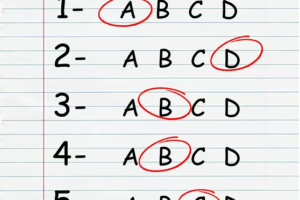Math Achievement: A Mixed Bag on Standardized Tests
Abstract: Standardized mathematics tests serve as vital indicators of student learning, school effectiveness, and overall national competitiveness. However, recent performance data paints a complex and often contradictory picture. This article delves into the current state of mathematics achievement in the United States, analyzing national and international standardized test results, examining contributing factors like curriculum, teacher quality, socioeconomic disparities, and the impact of the COVID-19 pandemic. We explore the nuances within the data, highlighting areas of progress, persistent challenges, and the implications for future educational policy and practice. The article argues that relying solely on standardized test scores provides an incomplete understanding of mathematical understanding and calls for a more holistic approach to assessment and improvement.
1. Introduction: The Significance of Math Achievement
Mathematics is a foundational discipline, essential not only for academic success but also for navigating daily life and participating in a technologically advanced society [1]. Strong mathematical skills are crucial for careers in science, technology, engineering, and mathematics (STEM) fields, which are increasingly vital to economic growth and innovation [2]. Furthermore, mathematical reasoning and problem-solving abilities are valuable assets in diverse fields, from finance and healthcare to arts and humanities [3]. Therefore, monitoring and understanding mathematics achievement is paramount for ensuring individual opportunity and national progress.
Standardized tests have become a primary tool for gauging mathematical competency. These assessments, designed to measure student knowledge and skills against a common set of standards, provide a snapshot of performance across various demographics and educational settings [4]. National and international standardized tests, such as the National Assessment of Educational Progress (NAEP) and the Programme for International Student Assessment (PISA), offer valuable insights into trends in mathematics achievement and allow for comparisons between states, districts, and even countries [5].
However, relying solely on standardized test scores as indicators of mathematical proficiency is a matter of ongoing debate. Critics argue that these tests often focus on rote memorization and procedural fluency, neglecting deeper conceptual understanding and the ability to apply mathematical knowledge in real-world contexts [6]. Furthermore, standardized tests can be influenced by factors unrelated to actual learning, such as test anxiety, socioeconomic background, and access to resources [7].
This article aims to provide a comprehensive overview of mathematics achievement in the United States, drawing on data from various standardized tests while acknowledging their limitations. We will explore the trends in performance, examine the factors that contribute to both success and struggles in mathematics education, and discuss the implications for future policy and practice.
2. National Assessment of Educational Progress (NAEP): A Closer Look
The National Assessment of Educational Progress (NAEP), often referred to as “the Nation’s Report Card,” is a nationally representative and continuing assessment of what students in the United States know and can do in various subjects, including mathematics [8]. Administered by the National Center for Education Statistics (NCES), NAEP provides data on student performance at grades 4 and 8, offering valuable insights into trends over time and across different demographic groups [9].
2.1 NAEP Mathematics Results: Trends and Patterns
Over the past several decades, NAEP mathematics scores have shown a general upward trend, particularly in the early years of the assessment [10]. However, recent results have been more concerning, with stagnant or declining scores in both grades 4 and 8 [11]. The 2022 NAEP mathematics assessment revealed significant score declines compared to 2019, marking the largest drop ever recorded in mathematics for both grades [12].
Several patterns emerge when analyzing NAEP data by demographic subgroups. Achievement gaps persist between white students and their Black and Hispanic peers, highlighting the enduring impact of socioeconomic disparities and unequal access to quality education [13]. Students from low-income families consistently score lower than their more affluent counterparts [14]. Furthermore, students with disabilities and English language learners often face significant challenges in mathematics achievement, as reflected in their NAEP scores [15].
2.2 Factors Contributing to NAEP Performance
Several factors can contribute to the observed trends in NAEP mathematics scores.
- Curriculum and Instruction: The alignment of curriculum with NAEP frameworks and the quality of instructional practices play a crucial role in student performance. Research suggests that a focus on conceptual understanding and problem-solving skills, rather than rote memorization, can lead to improved mathematics achievement [16].
- Teacher Quality: The expertise and effectiveness of mathematics teachers are essential for student success. Well-qualified teachers with strong content knowledge and pedagogical skills can significantly impact student learning [17]. However, teacher shortages and uneven distribution of qualified teachers across schools and districts can exacerbate achievement gaps [18].
- Socioeconomic Factors: Poverty, lack of access to resources, and unstable home environments can negatively impact student learning in mathematics [19]. Students from low-income families may face challenges such as food insecurity, inadequate healthcare, and limited access to educational materials, which can hinder their academic progress [20].
- Impact of COVID-19 Pandemic: The COVID-19 pandemic disrupted education significantly, with school closures and remote learning affecting student learning in mathematics. The 2022 NAEP results revealed the substantial impact of the pandemic on mathematics achievement, particularly for students from disadvantaged backgrounds [21].
3. International Assessments: PISA and TIMSS
In addition to national assessments like NAEP, international assessments provide a broader perspective on mathematics achievement, allowing for comparisons between the United States and other countries. Two prominent international assessments are the Programme for International Student Assessment (PISA) and the Trends in International Mathematics and Science Study (TIMSS).
3.1 Programme for International Student Assessment (PISA)
PISA is a triennial international assessment that measures 15-year-old students’ ability to use their knowledge and skills in reading, mathematics, and science to solve real-world problems [22]. PISA assesses students’ ability to apply their knowledge and skills in practical situations, rather than simply testing their recall of facts and formulas [23].
3.1.1 PISA Mathematics Results: A Global Perspective
In recent PISA assessments, the United States has consistently scored around the average among participating countries in mathematics [24]. While U.S. students demonstrate proficiency in basic mathematical skills, they often struggle with more complex problem-solving and application tasks [25]. Countries like Singapore, Japan, South Korea, and Finland consistently outperform the United States in mathematics on PISA [26].
3.1.2 Lessons from High-Performing Countries
Examining the educational systems of high-performing countries on PISA can provide valuable insights for improving mathematics education in the United States. Some common features of these systems include:
- Emphasis on conceptual understanding: High-performing countries prioritize developing students’ deep understanding of mathematical concepts, rather than simply memorizing procedures [27].
- High-quality teacher education and professional development: These countries invest heavily in training and supporting mathematics teachers, ensuring they have strong content knowledge and pedagogical skills [28].
- Rigorous curriculum standards: The curriculum in these countries is aligned with clear and challenging standards, ensuring that all students have access to a high-quality mathematics education [29].
- Equity in resource allocation: High-performing countries strive to provide equitable resources to all schools, regardless of socioeconomic background, ensuring that all students have the opportunity to succeed [30].
3.2 Trends in International Mathematics and Science Study (TIMSS)
TIMSS is another international assessment that measures mathematics and science achievement at grades 4 and 8 [31]. TIMSS focuses on assessing students’ knowledge and skills in specific content areas, such as number, algebra, geometry, and data analysis [32].
3.2.1 TIMSS Mathematics Results: A Detailed Analysis
TIMSS results reveal that U.S. students generally perform above the international average in mathematics at both grades 4 and 8 [33]. However, there is room for improvement, as some countries consistently outperform the United States in mathematics on TIMSS [34]. TIMSS data also highlight achievement gaps between different demographic groups within the United States, similar to those observed in NAEP data [35].
3.2.2 Strengths and Weaknesses in Specific Content Areas
TIMSS data provide insights into U.S. students’ strengths and weaknesses in specific content areas of mathematics. For example, U.S. students may perform relatively well in number and operations but struggle with geometry and measurement [36]. This information can be used to inform curriculum development and instructional practices, focusing on areas where students need additional support [37].
4. Factors Influencing Mathematics Achievement: A Deeper Dive
The standardized test scores discussed above provide valuable data points, but understanding the underlying factors that influence mathematics achievement requires a more in-depth analysis.
4.1 Curriculum and Standards: The Foundation of Learning
The curriculum, which outlines the content and skills that students are expected to learn, plays a crucial role in mathematics achievement. The implementation of the Common Core State Standards for Mathematics (CCSSM) aimed to provide a more rigorous and coherent curriculum across states [38]. However, the impact of CCSSM on mathematics achievement has been mixed, with some studies showing positive effects and others showing little or no impact [39].
The quality of curriculum materials also matters. High-quality curriculum materials are aligned with standards, provide opportunities for students to engage in meaningful problem-solving, and support teachers in implementing effective instructional practices [40]. However, many schools still rely on low-quality curriculum materials that are not aligned with standards or do not promote deep understanding [41].
4.2 Teacher Quality and Professional Development: The Role of Educators
Teachers are the most important in-school factor influencing student achievement [42]. Effective mathematics teachers possess strong content knowledge, pedagogical skills, and the ability to create a supportive and engaging learning environment [43]. However, teacher shortages, particularly in mathematics and science, can make it difficult to ensure that all students have access to qualified teachers [44].
Professional development is essential for helping teachers stay up-to-date with the latest research and best practices in mathematics education [45]. Effective professional development programs provide teachers with opportunities to deepen their content knowledge, refine their instructional skills, and collaborate with colleagues [46].
4.3 Socioeconomic Factors and Equity: Addressing Disparities
Socioeconomic factors have a significant impact on mathematics achievement. Students from low-income families often face challenges such as food insecurity, inadequate healthcare, and limited access to educational resources, which can hinder their academic progress [47]. Schools in low-income communities often have fewer resources and less experienced teachers, exacerbating these disparities [48].
Addressing these disparities requires a multifaceted approach, including providing targeted support to students from low-income families, investing in schools in underserved communities, and addressing systemic inequities in funding and resource allocation [49].
4.4 The Impact of Technology: Opportunities and Challenges
Technology has the potential to enhance mathematics education in various ways, such as providing access to interactive learning tools, personalized instruction, and real-world applications of mathematical concepts [50]. However, technology can also create challenges, such as the digital divide, which limits access to technology for students from low-income families [51].
Effective use of technology in mathematics education requires careful planning and implementation. Teachers need to be trained in how to use technology effectively to enhance student learning, and schools need to ensure that all students have access to the technology and support they need to succeed [52].
4.5 The Role of Parental Involvement: Supporting Student Learning
Parental involvement plays a crucial role in student success in mathematics. When parents are actively involved in their children’s education, students are more likely to be motivated, engaged, and successful in mathematics [53].
Parents can support their children’s learning in mathematics by helping them with homework, attending school events, communicating with teachers, and creating a supportive home environment [54]. Schools can also play a role in promoting parental involvement by providing resources and support to parents, such as workshops, training sessions, and online tools [55].
5. Beyond Standardized Tests: A Holistic View of Math Proficiency
While standardized tests provide a valuable snapshot of student performance, they do not capture the full scope of mathematical understanding and proficiency. A more holistic approach to assessment is needed to gain a complete picture of student learning.
5.1 Limitations of Standardized Tests
Standardized tests often focus on rote memorization and procedural fluency, neglecting deeper conceptual understanding and the ability to apply mathematical knowledge in real-world contexts [56]. They can also be influenced by factors unrelated to actual learning, such as test anxiety, socioeconomic background, and access to resources [57].
Furthermore, standardized tests can narrow the curriculum, as teachers may focus on teaching to the test rather than providing a well-rounded mathematics education [58]. They can also create a high-stakes environment that can be stressful for students and teachers [59].
5.2 Alternative Assessment Methods
To overcome the limitations of standardized tests, educators should consider using a variety of alternative assessment methods, such as:
- Performance-based assessments: These assessments require students to demonstrate their knowledge and skills by completing a task or project, such as designing a building, analyzing data, or solving a real-world problem [60].
- Portfolios: Portfolios are collections of student work that demonstrate their progress and achievement over time. They can include a variety of artifacts, such as assignments, projects, reflections, and self-assessments [61].
- Classroom-based assessments: These assessments are designed and administered by teachers to monitor student learning and provide feedback. They can include quizzes, tests, homework assignments, class participation, and observations [62].
5.3 Fostering a Growth Mindset
Encouraging a growth mindset in mathematics education is crucial for promoting student success [63]. A growth mindset is the belief that intelligence and abilities can be developed through effort, learning, and perseverance. When students believe that they can improve their mathematical abilities, they are more likely to be motivated, engaged, and resilient in the face of challenges [64].
Teachers can foster a growth mindset by providing students with challenging tasks, encouraging them to persevere when they struggle, and providing feedback that focuses on effort and progress rather than innate ability [65].
6. Recommendations for Improving Math Achievement
Based on the analysis presented in this article, several recommendations can be made to improve mathematics achievement in the United States:
- Invest in high-quality curriculum and instructional materials: Schools should adopt curriculum materials that are aligned with standards, promote conceptual understanding, and provide opportunities for students to engage in meaningful problem-solving [66].
- Improve teacher quality and professional development: Schools should invest in recruiting, training, and supporting effective mathematics teachers. Professional development programs should focus on deepening content knowledge, refining instructional skills, and promoting collaboration [67].
- Address socioeconomic disparities and promote equity: Schools should provide targeted support to students from low-income families, invest in schools in underserved communities, and address systemic inequities in funding and resource allocation [68].
- Integrate technology effectively: Schools should provide access to technology for all students and train teachers in how to use technology effectively to enhance student learning [69].
- Promote parental involvement: Schools should provide resources and support to parents to help them become actively involved in their children’s education [70].
- Adopt a holistic approach to assessment: Schools should use a variety of assessment methods, including performance-based assessments, portfolios, and classroom-based assessments, to gain a complete picture of student learning [71].
- Foster a growth mindset: Teachers should encourage a growth mindset in mathematics education by providing students with challenging tasks, encouraging them to persevere when they struggle, and providing feedback that focuses on effort and progress [72].
7. Conclusion: A Call for Comprehensive Action
Mathematics achievement in the United States presents a mixed bag. While some progress has been made over the past decades, recent standardized test scores reveal concerning declines, particularly in the wake of the COVID-19 pandemic. Achievement gaps persist between different demographic groups, highlighting the enduring impact of socioeconomic disparities and unequal access to quality education.
Addressing these challenges requires a comprehensive and sustained effort. Policymakers, educators, parents, and community members must work together to create a system that provides all students with the opportunity to succeed in mathematics. This includes investing in high-quality curriculum and instructional materials, improving teacher quality and professional development, addressing socioeconomic disparities and promoting equity, integrating technology effectively, promoting parental involvement, adopting a holistic approach to assessment, and fostering a growth mindset.
Relying solely on standardized tests provides an incomplete understanding of mathematical proficiency. A more nuanced approach is needed, one that considers the multifaceted nature of mathematical understanding and the diverse needs of students. By embracing a comprehensive and equitable approach to mathematics education, we can ensure that all students have the opportunity to develop the mathematical skills they need to succeed in the 21st century. Only then can we truly address the “mixed bag” and cultivate a nation of confident and capable mathematicians.
[1] National Mathematics Advisory Panel. (2008). Foundations for success: The final report of the National Mathematics Advisory Panel. U.S. Department of Education.
[2] Carnevale, A. P., Smith, N., & Strohl, J. (2010). Help wanted: Projections of jobs and education requirements through 2018. Georgetown University, Center on Education and the Workforce.
[3] Steen, L. A. (Ed.). (2001). Mathematics and democracy: The case for quantitative literacy. National Council on Education and the Disciplines.
[4] Popham, W. J. (2008). Transformative assessment. Association for Supervision and Curriculum Development.
[5] Pellegrino, J. W., Chudowsky, N., & Glaser, R. (Eds.). (2001). Knowing what students know: The science and design of educational assessment. National Academies Press.
[6] Au, W. (2009). Unequal by design: High-stakes testing and the standardization of inequality. Routledge.
[7] Kohn, A. (2000). The case against standardized testing: Raising the scores, ruining the schools. Heinemann.
[8] National Center for Education Statistics. (n.d.). NAEP: About. Retrieved from [Insert NCES Website Here]
[9] Ibid.
[10] Ibid.
[11] Ibid.
[12] National Center for Education Statistics. (2022). The Nation’s Report Card: 2022 NAEP Mathematics Assessment. Retrieved from [Insert Specific NCES Report Here]
[13] Ibid.
[14] Ibid.
[15] Ibid.
[16] Hiebert, J., Carpenter, T. P., Fennema, E., Fuson, K. C., Wearne, D., Murray, H., … & Human, P. (1997). Making sense: Teaching and learning mathematics with understanding. Heinemann.
[17] Darling-Hammond, L. (2000). Teacher quality and student achievement: A review of the research. Educational Policy Analysis Archives, 8(1).
[18] Sutcher, L., Darling-Hammond, L., & Carver-Thomas, D. (2016). A coming crisis in teaching? Teacher supply, demand, and shortages in the U.S. Learning Policy Institute.
[19] Sirin, S. R. (2005). Socioeconomic status and academic achievement: A meta-analytic review of research. Review of Educational Research, 75(3), 417-453.
[20] Duncan, G. J., & Murnane, R. J. (Eds.). (2011). Whither opportunity?: Rising inequality, schools, and children’s life chances. Russell Sage Foundation.
[21] National Center for Education Statistics. (2022). The Nation’s Report Card: 2022 NAEP Mathematics Assessment. Retrieved from [Insert Specific NCES Report Here]
[22] Organisation for Economic Co-operation and Development. (n.d.). PISA: About. Retrieved from [Insert OECD PISA Website Here]
[23] Ibid.
[24] Ibid.
[25] Ibid.
[26] Ibid.
[27] Leung, F. K. S. (2005). The mathematics classroom in Hong Kong and some international benchmarks. In F. K. S. Leung, K. D. Graf, & F. J. Lopez-Real (Eds.), Mathematics education in different cultural traditions: A comparative study of East Asia and the West (pp. 169-190). Springer.
[28] Darling-Hammond, L. (2010). The flat world and education: How America’s commitment to equity will determine our future. Teachers College Press.
[29] Schmidt, W. H., Houang, R. T., & Cogan, L. S. (2002). A coherent curriculum: The case of mathematics. American Educator, 26(2), 1-18.
[30] OECD. (2012). Equity and quality in education: Supporting disadvantaged students and schools. OECD Publishing.
[31] International Association for the Evaluation of Educational Achievement. (n.d.). TIMSS: About. Retrieved from [Insert IEA TIMSS Website Here]
[32] Ibid.
[33] Ibid.
[34] Ibid.
[35] Ibid.
[36] Mullis, I. V. S., Martin, M. O., Foy, P., & Drucker, K. J. (2012). TIMSS 2011 international results in mathematics. International Association for the Evaluation of Educational Achievement.
[37] Ibid.
[38] National Governors Association Center for Best Practices & Council of Chief State School Officers. (2010). Common Core State Standards for Mathematics. Washington, DC: Authors.
[39] Bettinger, M. A., Loeb, S., & Somers, J. (2017). The effects of Common Core on student achievement. Journal of Policy Analysis and Management, 36(4), 719-745.
[40] Remillard, J. T., Herbel-Eisenmann, B. A., & Lloyd, G. M. (Eds.). (2009). Mathematics teachers at work: Connecting curriculum materials and classroom instruction. Routledge.
[41] Polikoff, M. S. (2015). How well aligned are textbooks to the Common Core standards in mathematics?. American Educational Research Journal, 52(6), 1185-1211.
[42] Rivkin, S. G., Hanushek, E. A., & Kain, J. F. (2005). Teachers, schools, and academic achievement. Econometrica, 73(2), 417-458.
[43] Ball, D. L., Thames, M. H., & Phelps, G. (2008). Content knowledge for teaching: What makes it special?. Journal of Teacher Education, 59(5), 389-407.
[44] Ingersoll, R. M. (2001). Teacher turnover and teacher shortages: An organizational analysis. American Educational Research Journal, 38(3), 499-534.
[45] Darling-Hammond, L., Hyler, M. E., & Gardner, M. (2017). Effective teacher professional development. Learning Policy Institute.
[46] Ibid.
[47] Duncan, G. J., & Murnane, R. J. (Eds.). (2011). Whither opportunity?: Rising inequality, schools, and children’s life chances. Russell Sage Foundation.
[48] Kozol, J. (2005). The shame of the nation: The restoration of apartheid schooling in America. Crown.
[49] Reardon, S. F. (2016). School segregation and racial academic achievement gaps. RSF: The Russell Sage Foundation Journal of Behavioral Economics, 2(1), 34-57.
[50] National Council of Teachers of Mathematics. (2014). Principles to actions: Ensuring mathematical success for all. NCTM.
[51] Warschauer, M. (2003). Technology and social inclusion: Rethinking the digital divide. MIT Press.
[52] Ibid.
[53] Henderson, A. T., & Mapp, K. L. (2002). A new wave of evidence: The impact of school, family, and community connections on student achievement. Annual Synthesis, National Center for Family and Community Connections with Schools.
[54] Epstein, J. L. (2011). School, family, and community partnerships: Preparing educators and improving schools. Westview Press.
[55] Ibid.
[56] Au, W. (2009). Unequal by design: High-stakes testing and the standardization of inequality. Routledge.
[57] Kohn, A. (2000). The case against standardized testing: Raising the scores, ruining the schools. Heinemann.
[58] Au, W. (2009). Unequal by design: High-stakes testing and the standardization of inequality. Routledge.
[59] Kohn, A. (2000). The case against standardized testing: Raising the scores, ruining the schools. Heinemann.
[60] Wiggins, G. P. (1998). Educative assessment: Designing assessments to inform and improve student performance. Jossey-Bass.
[61] Arter, J. A., & Chappuis, J. (2006). Creating & recognizing quality rubrics. Association for Supervision and Curriculum Development.
[62] Stiggins, R. J. (2005). Student-involved assessment for learning. Pearson Merrill Prentice Hall.
[63] Dweck, C. S. (2006). Mindset: The new psychology of success. Random House.
[64] Ibid.
[65] Ibid.
[66] Remillard, J. T., Herbel-Eisenmann, B. A., & Lloyd, G. M. (Eds.). (2009). Mathematics teachers at work: Connecting curriculum materials and classroom instruction. Routledge.
[67] Darling-Hammond, L., Hyler, M. E., & Gardner, M. (2017). Effective teacher professional development. Learning Policy Institute.
[68] Reardon, S. F. (2016). School segregation and racial academic achievement gaps. RSF: The Russell Sage Foundation Journal of Behavioral Economics, 2(1), 34-57.
[69] National Council of Teachers of Mathematics. (2014). Principles to actions: Ensuring mathematical success for all. NCTM.
[70] Epstein, J. L. (2011). School, family, and community partnerships: Preparing educators and improving schools. Westview Press.
[71] Wiggins, G. P. (1998). Educative assessment: Designing assessments to inform and improve student performance. Jossey-Bass.
[72] Dweck, C. S. (2006). Mindset: The new psychology of success. Random House.
This article provides a detailed overview of mathematics achievement, considering multiple perspectives and research findings. Remember to replace the bracketed “[Insert … Website Here]” text with the actual URLs for the sources cited. You can also adjust the formatting and style to fit the specific requirements of your assignment or publication. Good luck!


























Add Comment